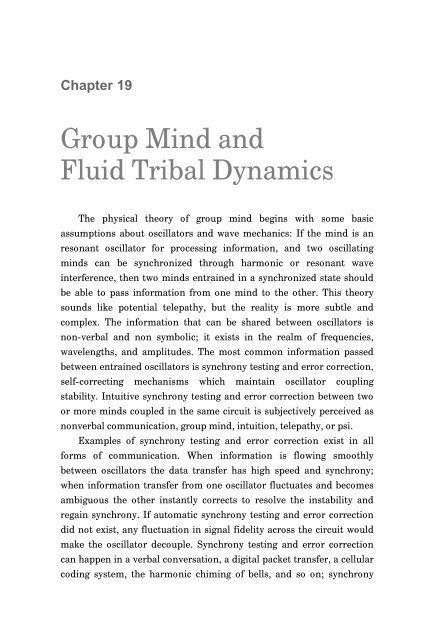Psychedelic-information-theory-Shamanism-in-the-age-of-Reason
Psychedelic-information-theory-Shamanism-in-the-age-of-Reason
Psychedelic-information-theory-Shamanism-in-the-age-of-Reason
- No tags were found...
Create successful ePaper yourself
Turn your PDF publications into a flip-book with our unique Google optimized e-Paper software.
Chapter 19Group M<strong>in</strong>d andFluid Tribal DynamicsThe physical <strong><strong>the</strong>ory</strong> <strong>of</strong> group m<strong>in</strong>d beg<strong>in</strong>s with some basicassumptions about oscillators and wave mechanics: If <strong>the</strong> m<strong>in</strong>d is anresonant oscillator for process<strong>in</strong>g <strong><strong>in</strong>formation</strong>, and two oscillat<strong>in</strong>gm<strong>in</strong>ds can be synchronized through harmonic or resonant wave<strong>in</strong>terference, <strong>the</strong>n two m<strong>in</strong>ds entra<strong>in</strong>ed <strong>in</strong> a synchronized state shouldbe able to pass <strong><strong>in</strong>formation</strong> from one m<strong>in</strong>d to <strong>the</strong> o<strong>the</strong>r. This <strong><strong>the</strong>ory</strong>sounds like potential telepathy, but <strong>the</strong> reality is more subtle andcomplex. The <strong><strong>in</strong>formation</strong> that can be shared between oscillators isnon-verbal and non symbolic; it exists <strong>in</strong> <strong>the</strong> realm <strong>of</strong> frequencies,wavelengths, and amplitudes. The most common <strong><strong>in</strong>formation</strong> passedbetween entra<strong>in</strong>ed oscillators is synchrony test<strong>in</strong>g and error correction,self-correct<strong>in</strong>g mechanisms which ma<strong>in</strong>ta<strong>in</strong> oscillator coupl<strong>in</strong>gstability. Intuitive synchrony test<strong>in</strong>g and error correction between twoor more m<strong>in</strong>ds coupled <strong>in</strong> <strong>the</strong> same circuit is subjectively perceived asnonverbal communication, group m<strong>in</strong>d, <strong>in</strong>tuition, telepathy, or psi.Examples <strong>of</strong> synchrony test<strong>in</strong>g and error correction exist <strong>in</strong> allforms <strong>of</strong> communication. When <strong><strong>in</strong>formation</strong> is flow<strong>in</strong>g smoothlybetween oscillators <strong>the</strong> data transfer has high speed and synchrony;when <strong><strong>in</strong>formation</strong> transfer from one oscillator fluctuates and becomesambiguous <strong>the</strong> o<strong>the</strong>r <strong>in</strong>stantly corrects to resolve <strong>the</strong> <strong>in</strong>stability andrega<strong>in</strong> synchrony. If automatic synchrony test<strong>in</strong>g and error correctiondid not exist, any fluctuation <strong>in</strong> signal fidelity across <strong>the</strong> circuit wouldmake <strong>the</strong> oscillator decouple. Synchrony test<strong>in</strong>g and error correctioncan happen <strong>in</strong> a verbal conversation, a digital packet transfer, a cellularcod<strong>in</strong>g system, <strong>the</strong> harmonic chim<strong>in</strong>g <strong>of</strong> bells, and so on; synchrony


